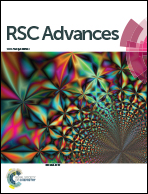Preparation of Au@Ag nanoparticles at a gas/liquid interface and their application for sensitive detection of hydrogen peroxide
Abstract
Au@Ag nanoparticles (NPs) were prepared by a seed-mediated growth procedure using spherical Au NPs as seeds at a gas/liquid interface and further used to fabricate a nonenzymatic hydrogen peroxide (H2O2) sensor. The as-prepared Au@Ag NPs were characterized by UV-visible spectroscopy, transmission electron microscopy (TEM) and dynamic light scattering (DLS). TEM and DLS analysis indicates that the obtained Au@Ag NPs are highly dispersed and possess narrow size distributions. The electrochemical behavior of the nonenzymatic sensor suggests that the Au@Ag NPs modified glassy carbon electrode exhibited a high sensitivity of 251.9 μA mM−1 cm−2 for electrochemical detection of H2O2 at a potential as low as −0.1 V. The results demonstrate that Au@Ag NPs should be promising materials for an electrochemical sensor in practical applications.


 Please wait while we load your content...
Please wait while we load your content...